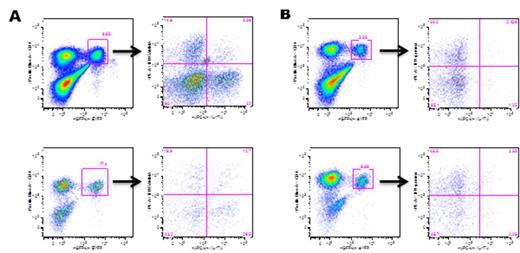Abstract
Background: Allogeneic hematopoietic stem cell transplantation (allo HSCT) is used to treat a variety of acquired and congenital diseases; however, a major complication of allo HSCT is graft versus host disease (GvHD). Immunosuppressive drugs are the standard treatment for GvHD but can predispose patients to opportunistic infections. Therefore, it is of great importance to further understand the underlying mechanisms that mediate GvHD pathogenesis in order to develop novel therapeutic treatments.
Studies demonstrate that Th17 cells play an important role in the pathogenesis of various inflammatory and autoimmune diseases. Previous work from our lab suggests Th17 cells can mediate acute GvHD. However, Th17 cells are much more difficult to detect in areas of inflammation than Th1 cells. Interestingly, recent studies have shown that Th17 cells are plastic and can shift to a Th1 phenotype in vivo. Therefore, we wanted to determine whether Th17 cells shifted to another polarized T cell population after transplant and if this occurred which type of T cell was generated.
Methods: For our transplantation experiments we utilized IL17aCreRosa26ReYFP reporter mice on a C57BL/6 (“B6”) background (H-2b) as donors. Cells from these mice are permanently labeled with eYFP if they produce IL-17a at any point over the course of their lifespan, even if they are no longer actively generating the cytokine. Haplotype matched B6xDBA2 F1 mice (“B6D2”, H-2b/d) were used as recipients. In brief, B6D2 mice were lethally irradiated on day -1, and the following day, recipient mice received 3 x 106 T cell depleted bone marrow (TCD BM) cells with either 4 x 106 cells activated, ex vivo polarized Th17 cells or naïve conventional T cells (Tcons) obtained from IL17aCreRosa26ReYFP mice. Recipient lymphoid or GvHD target organs were subsequently harvested and utilized for intracellular cytokine staining and flow cytometric analysis at various time points.
Results: When ex vivo polarized Th17 cells from reporter mice were administered to recipient mice, we found IL-17+eYFP+ cells early in secondary lymphoid tissue on transplant day +8. Over the following 10 days, however, there was a marked decrease in the number of eYFP+ T cells generating IL-17. Concomitant with this, there was an increase in the percentage of donor eYFP+ T cells only making IFNγ (Fig 1) in GvHD target organs. Similarly, when naïve reporter Tcons were given to recipient animals, we found a population of IL-17+eYFP+ cells on transplant day +4. By transplant day +12, however, these cells could no longer be identified in recipient mice. Instead, there was a marked increase in the number of IFNγ+eYFP+ cells. When we transplanted naïve reporter Tcons, we found that approximately 10-20% of the total donor Th1 cells were generated from T cells previously producing IL-17. These “exTh17” Th1 cells appeared to be indistinguishable from those Th1 cells polarized initially after transplant.
Conclusion: These studies demonstrate that Th17 cells, present early after transplant, convert to Th1 cells during the course of acute GvHD. Thus, exTh17 cells may contribute significantly to the pool of Th1 cells after bone marrow transplantation. Our data are consistent with initial priming of donor Th17 cells in secondary lymphoid tissue and subsequent conversion of these T cells to Th1 cells in target organs.
Flow cytometric analysis of organs from transplanted mice receiving reporter TH17 cells. A. Day 8 analysis from spleen (top panel) and mesenteric lymph node (MLN, bottom panel). B. Day 18 analysis from mice lung (top panel) and liver (bottom panel). N=3 mice
Flow cytometric analysis of organs from transplanted mice receiving reporter TH17 cells. A. Day 8 analysis from spleen (top panel) and mesenteric lymph node (MLN, bottom panel). B. Day 18 analysis from mice lung (top panel) and liver (bottom panel). N=3 mice
No relevant conflicts of interest to declare.
Author notes
Asterisk with author names denotes non-ASH members.


This feature is available to Subscribers Only
Sign In or Create an Account Close Modal